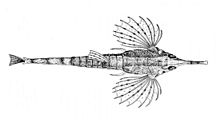
Mackerel is a common name applied to a number of different species of pelagic fish, mostly from the family Scombridae. They are found in both temperate and tropical seas, mostly living along the coast or offshore in the oceanic environment.

Herring are forage fish, mostly belonging to the family of Clupeidae.

The red lionfish is a venomous coral reef fish in the family Scorpaenidae, order Scorpaeniformes. It is mainly native to the Indo-Pacific region, but has become an invasive species in the Caribbean Sea, as well as along the East Coast of the United States and East Mediterranean and also found in Brazil at Fernando de Noronha.

The Mesoamerican Barrier Reef System (MBRS), also popularly known as the Great Mayan Reef or Great Maya Reef, is a marine region that stretches over 1,126 kilometres (700 mi) along the coasts of four countries – Mexico, Belize, Guatemala, and Honduras – from Isla Contoy at the northern tip of the Yucatán Peninsula south to Belize, Guatemala and the Bay Islands of Honduras. The reef system includes various protected areas and parks including the Belize Barrier Reef, Arrecifes de Cozumel National Park, Hol Chan Marine Reserve (Belize), Sian Ka'an biosphere reserve, and the Cayos Cochinos Marine Park. Belize's coastline, including the Belize Barrier Reef, is home to approximately 30% of the Mesoamerican Barrier Reef System.

The seamoths make up a family of fishes, the Pegasidae, within the order Syngnathiformes. They are named for Pegasus, a creature from Greek mythology. Seamoths are notable for their unusual appearance, including flattened bodies, the presence of large, wing-like, pectoral fins, a long snout, and a body encased in thick, bony plates. They are found primarily in coastal tropical waters of the Indo-Pacific.

Pterois miles, the devil firefish or common lionfish, is a species of ray-finned fish native to the western Indo-Pacific region. It is frequently confused with its close relative, the red lionfish. The scientific name is from Greek pteron, meaning "wing", and Latin miles, meaning "soldier".
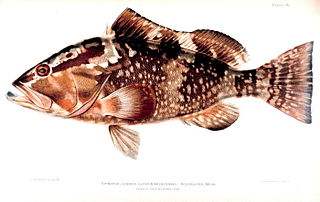
The red grouper is a species of marine ray-finned fish, a grouper from the subfamily Epinephelinae which is part of the family Serranidae, which also includes the anthias and sea basses. It is found in the western Atlantic Ocean.

The brick seamoth, Pegasus laternarius, also known as the long-tailed dragonfish, long-tailed seamoth, pelagic dragon-fish, or the winged dragonfish, is a species of fish in the Pegasidae, or seamoth, family. This species is used extensively in the Guangdong and Guangxi province of China to treat scrofula, cough, and diarrhea.
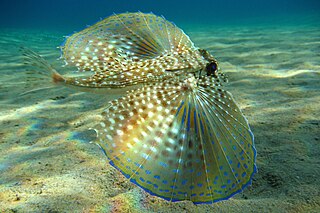
The flying gurnard, also known as the helmet gurnard, is a bottom-dwelling fish of tropical to warm temperate waters on both sides of the Atlantic. On the American side, it is found as far north as Massachusetts and as far south as Argentina, including the Caribbean and Gulf of Mexico. On the European and African side, it ranges from the English Channel to Angola, including the Mediterranean. This is the only species in the monotypic genus Dactylopterus. Similar and related species from the genus Dactyloptena are found in the Indian and Pacific Oceans.

Pegasus is a genus of seamoths found in coastal tropical marine waters. The name was taken from the winged horse Pegasus in Greek mythology. This horse was created with Medusa´s blood. The member species are distributed in the Indo-West Pacific Ocean waters around: Australia, Bahrain, China, India, Indonesia, Japan, Malaysia, Mozambique, Myanmar, the Philippines, Saudi Arabia, Singapore, Taiwan, Tanzania and Thailand.
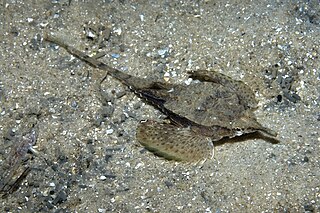
Pegasus lancifer, the sculptured seamoth or sculptured dragonfish, is a species of fish in the family Pegasidae which is endemic to the temperate seas of southern Australia and Tasmania. They are known to gather in large numbers in the shallows of estuaries. Individuals can bury themselves in the sediment and change colours to camouflage them. The male & female spawn as a pair, swimming with their vents touching around a 1 metre (3.3 ft) above the substrate, while the eggs and sperm are released. After spawning the pair separates and the eggs begin a pelagic phase.

Pterois russelii, the largetail turkeyfish, plaintail firefish, plaintail turkeyfish, Russell's firefish, Russell's lionfish, spotless butterfly-cod or the spotless firefish, is a species of ray-finned fish with venomous spines belonging to the family Scorpaenidae, the scorpionfishes and lionfishes. It is native to the Indo-Pacific Ocean from the eastern part of Africa to the Persian Gulf.

Pterois is a genus of venomous marine fish, commonly known as lionfish, native to the Indo-Pacific. Also called firefish, turkeyfish, tastyfish, or butterfly-cod, it is characterized by conspicuous warning coloration with red, white, creamy, or black bands, showy pectoral fins, and venomous, spiky fin rays. Pterois radiata, Pterois volitans, and Pterois miles are the most commonly studied species in the genus. Pterois species are popular aquarium fish. P. volitans and P. miles are recent and significant invasive species in the west Atlantic, Caribbean Sea and Mediterranean Sea.

The Luna lionfish, the dragon's beard fish or Japanese lionfish, is a species of marine ray-finned fish belonging to the family Scorpaenidae, which consists of scorpionfishes and lionfishes. It is found in the western Pacific Ocean.

Pegasus tetrabelos is a species of coastal sea moth which occurs over muddy and sandy substrates in seas off northeastern Australia. It was described in 2016, separated from the more widespread and sympatric P. volitans.
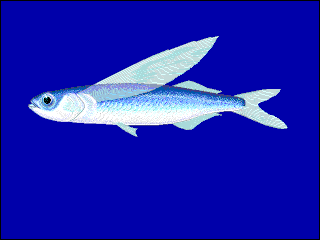
Exocoetus volitans, commonly known as the tropical two-wing flyingfish or blue flyingfish, is a species of ray-finned fish native to tropical and subtropical seas. It can glide above the surface of the sea to escape predators.

Exocoetus obtusirostris, commonly known as the oceanic two-wing flyingfish or the blunt-snouted flyingfish, is a species of ray-finned fish native to the tropical and subtropical western Atlantic Ocean. It has the ability to glide above the surface of the water to escape from predators.
Elacatinus atronasus is a species of ray-finned fish in the family Gobiidae which is endemic to a single reef in Exuma Sound in the Bahamas. It is a species associated with a coral reefs but unlike many other species in the genus Elacatinus it does not engage in cleaning behaviour, feeding instead on particulate zooplankton. It occurs in large, mixed groups in the vicinity of vertical faces which have plentiful holes and near undercut ledges. It forms schools above the sea floor where has been recorded as remaining stationary, hovering above corals by day, resting on the coral during the night. Its reproductive behaviour is unknown. The IUCN assess Elacatinus atronasus as endangered due to its restricted range and the perceived vulnerability of this species to predation by the invasive lionfish, Pterois miles and Pterois volitans.
